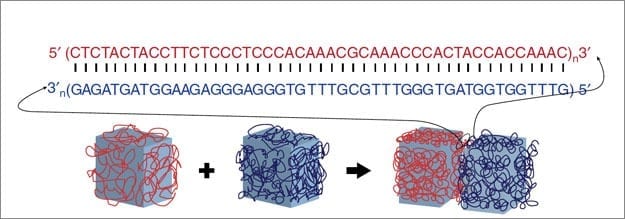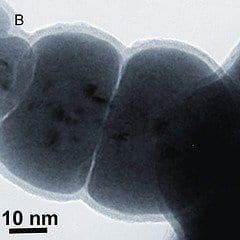
New method could help to reconnect injured organs or build functional human tissues from the ground up
A team of researchers at the Wyss Institute for Biologically Inspired Engineering at Harvard University has found a way to self-assemble complex structures out of bricks smaller than a grain of salt. The self-assembly method could help solve one of the major challenges in tissue engineering: regrowing human tissue by injecting tiny components into the body that then self-assemble into larger, intricately structured, biocompatible scaffolds at an injury site.
The key to self-assembly was developing the world’s first programmable glue. The glue is made of DNA, and it directs specific bricks of a water-filled gel to stick only to each other, the scientists report in the September 9th online issue of Nature Communications.
“By using DNA glue to guide gel bricks to self-assemble, we’re creating sophisticated programmable architecture,” says Peng Yin, Ph.D., a Core Faculty member at the Wyss Institute and senior coauthor of the study, who is also an Assistant Professor of Systems Biology at Harvard Medical School. This novel self-assembly method worked for gel bricks from as small as a speck of silt (30 microns diameter) to as large as a grain of sand (1 millimeter diameter), underscoring the method’s versatility.
The programmable DNA glue could also be used with other materials to create a variety of small, self-assembling devices, including lenses, reconfigurable microchips, and surgical glue that could knit together only the desired tissues, said Ali Khademhosseini, Ph.D., an Associate Faculty member at the Wyss Institute who is the other senior coauthor of the study.
“It could work for anything where you’d want a programmable glue to induce assembly of higher-order structures, with great control over their final architecture — and that’s very exciting,” said Khademhosseini, who is also an Associate Professor at Harvard-MIT’s Division of Health Sciences and Technology (HST), Brigham and Women’s Hospital, and Harvard Medical School.
To fabricate devices or their component parts, manufacturers often start with a single piece of material, then modify it until it has the desired properties. In other cases, they employ the same strategy as auto manufacturers, making components with the desired properties, then assembling them to produce the final device. Living organisms fabricate their tissues using a similar strategy, in which different types of cells assemble into functional building blocks that generate the appropriate tissue function. In the liver, for example, the functional building blocks are small tissue units called lobules. In muscle tissue, the functional building blocks are muscle fibers.
Scientists have tried to mimic this manufacturing strategy by developing self-assembling systems to fabricate devices. For example, last year Yin and his team reported in Science that they had developed miniscule “DNA bricks” smaller than the tiniest virus that self-assemble into complex nanoscale 3D structures.
Now, he and Khademhosseini sought to create a similar programmable, self-assembling system for mesoscale components — those with edge widths ranging from 30 microns to 1000 microns (1 millimeter). They focused first on creating a system in which bricks of biocompatible, biodegradable gels called hydrogels self-assemble into complex structures. For future applications, small hydrogel bricks containing human cells could potentially be injected into the body. The bricks would assemble, then the cells would knit together to form functional tissue as the hydrogels break down.
In previous attempts to self-assemble hydrogel bricks into complex structures, scientists faced a challenge: the bricks often glom onto one another rather than assembling into the desired architecture. Yin and Khademhosseini needed a way to help each component stick only to specific partners, but not to other components. In other words, they needed programmable glue.
“Designing a strategy that leverages the power of self assembly used by living systems to direct construction of tissues from tiny component parts represents an entirely new approach for tissue engineering,” said Don Ingber, M.D., Ph.D., the Wyss Institute’s Founding Director. “Peng and Ali have created an elegant and straightforward method that could permit tissues to be reconstructed from within after a simple injection, rather than requiring major surgery.”
The Latest Bing News on:
Programmable glue
- Why Enterprises Should Prioritize 'Cost Composability' Over 'Cost Takeout' For Hybrid Operationson May 9, 2024 at 3:30 am
Similar to how the cloud enables the composability of IT (infrastructure, data, security and apps) through a programmable core ... Copilot and OpenAI's GPT—or a next-gen AWS Stack—Glue, SageMaker, ...
- Allergic Contact Dermatitis from Medical Adhesive Bandages in Patients Who Report Having a Reaction to Medical Bandageson May 7, 2024 at 5:00 pm
Background: Medical adhesive bandages are extensively used in both inpatient and outpatient medicine. However, few reports describing proven allergic contact dermatitis (ACD) from medical adhesive ...
- Why Boob Tape and Nipple Covers Are Your New Best Friendson May 4, 2024 at 10:13 am
Let's face it, we've all had our share of wardrobe malfunctions. Whether it's a plunging neckline or a backless dress, ...
- Programmable hydrogels could herald a new era in wound careon February 12, 2024 at 8:23 am
When it comes to wound care, this means that the adhesive gel can be programmed to form strong bonds with healthy tissue and weak bonds with wounded tissue, preventing secondary damage. "This work is ...
- Stained Glass Glueon November 26, 2023 at 10:40 am
In the activity below, you can make a colorful art material that looks bright in the light! Place 2 tablespoons of Elmer's glue in a small cup and add 2 teaspoons of water. Stir with a popsicle stick ...
- Time for Slimeon November 11, 2023 at 6:24 am
2. Place 1 tablespoon of water in another cup and add 1 tablespoon of Elmer's glue. Stir with a popsicle stick until the glue and water are thoroughly mixed. This is your glue solution. 3. Slowly pour ...
- Using EPROMS And EEPROMs As Programmable Logic With Lispon October 29, 2023 at 4:31 am
but feature many more programmable elements to allow for more complex logic. If all you need is a bit of glue logic and you are looking for something in between a stack of 74-logic ICs and a CPLD ...
- 3 Things To Know About AWS Glue DataBrewon November 13, 2020 at 2:49 pm
Amazon Web Services’ new visual data preparation tool for AWS Glue includes 250 pre-built functions to automate data preparation tasks without writing code. Amazon Web Services’ new visual ...
- Mr. Coffee Programmable Automatic BVMC-VMX38-DSon May 26, 2018 at 7:42 am
The one- or two-mug drip models are based on 10 oz. of water. The Mr. Coffee Programmable Automatic BVMC-VMX38-DS is part of the Coffee Makers test program at Consumer Reports. In our lab tests ...
- New Part Day: ATMegas With Programmable Logicon March 1, 2018 at 8:30 pm
Basically, it’s a tiny bit of programmable glue logic. In the application note, Microchip provided an example of debouncing a switch using the CCL. It’s a simple enough example, and it’ll ...
The Latest Google Headlines on:
Programmable glue
[google_news title=”” keyword=”programmable glue” num_posts=”10″ blurb_length=”0″ show_thumb=”left”]
The Latest Bing News on:
Programmable DNA glue
- Scientists developed innovative method to customize and strengthen DNA origami structureson May 8, 2024 at 5:00 pm
(Nanowerk News) A new technique in building DNA structures at a microscopic level has the potential to advance drug delivery and disease diagnosis, a study suggests. A team of scientists, from the ...
- Ancient DNA Newson May 4, 2024 at 5:00 pm
DNA Study IDs Descendants of George Washington from Unmarked Remains, Findings to Aid Service Member IDs Going Back to World War II Mar. 28, 2024 — New DNA sequencing technologies have ...
- Best DNA Test for 2024on May 3, 2024 at 4:01 am
CNET’s expert staff reviews and rates dozens of new products and services each month, building on more than a quarter century of expertise. Open up even more of your world with the best at-home ...
- Marriage of synthetic biology and 3D printing produces programmable living materialson May 1, 2024 at 6:42 am
Scientists are harnessing cells to make new types of materials that can grow, repair themselves and even respond to their environment. These solid "engineered living materials" are made by embedding ...
- Crafting Programmable Living Materials With Synthetic Biology & 3D Printingon May 1, 2024 at 4:59 am
New study uses 3D printing and genetically modified plant cells to create complex, self-repairing materials that could revolutionize biomanufacturing and construction. Scientists are harnessing cells ...
- Beyond biology: Creating dynamic synthetic cells with programmable DNAon April 24, 2024 at 6:40 am
In a new study published in Nature Chemistry, UNC-Chapel Hill researcher Ronit Freeman and her colleagues describe the steps they took to manipulate DNA and proteins -; essential building blocks of ...
- Artificial Cells Built with Programmable Peptide-DNA Cytoskeletonson April 22, 2024 at 4:59 pm
Specifically, the scientists engineered artificial cells using a programmable peptide–DNA nanotechnology approach. Details recently appeared in Nature Chemistry, in an article titled ...
- Nathan Derron April 17, 2024 at 1:37 pm
Derr ND*, Goodman BS*, Jungman R, Leschziner AE, Shih WM, Reck-Peterson SL. (2012) Tug of War in Motor Protein Ensembles Revealed with a Programmable DNA Origami Scaffold. Science 338, 662-665.
- Neuroscientists Discover Shapeshifting DNA Controls Memory Formationon April 17, 2024 at 9:16 am
Neuroscientists have uncovered a new mechanism for memory formation, and it involves changes in the structure of your DNA. If you were asked to picture a molecule of DNA, chances are you would ...
- Save $40 on this Smart Programmable Thermostat with Alexaon March 8, 2024 at 4:09 pm
So hurry while they are still available. The Amazon Smart Programmable Thermostat with Alexa, currently priced at $59.99, is designed as a smart upgrade from traditional thermostats, aiming to ...
The Latest Google Headlines on:
Programmable DNA glue
[google_news title=”” keyword=”programmable DNA glue” num_posts=”10″ blurb_length=”0″ show_thumb=”left”]










